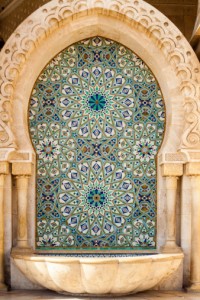A Brief History of Mosaic Tile Art
For thousands of years, people have been adorning surfaces with beautiful, intricate tile mosaics
 For whatever reason, the urge to create large, intricate works of art from tiny little pieces that would be quite boring on their own has been with us for thousands of years. By most accounts it started with the creation of stone, shell, and ivory mosaics in Mesopotamia over 3500 years ago, and it’s continued to this day with artists creating large mosaic portraits with everything from photos to postage stamps to gumballs. Here are some of the highlights in the history of mosaic art.
For whatever reason, the urge to create large, intricate works of art from tiny little pieces that would be quite boring on their own has been with us for thousands of years. By most accounts it started with the creation of stone, shell, and ivory mosaics in Mesopotamia over 3500 years ago, and it’s continued to this day with artists creating large mosaic portraits with everything from photos to postage stamps to gumballs. Here are some of the highlights in the history of mosaic art.
Roman Empire
By 200 BC, mosaics were so en vogue in the Roman Empire that fortunes could be made in the manufacture of the small “tesserae” or uniform, pre-made pieces used to create mosaics. Squares of marble and other stones were used to create sprawling floor mosaics depicting scenes of the gods and of everyday Roman life.
Byzantine Empire
The Byzantine Empire elevated mosaics from the floor to wall and ceilings and began using beautiful glass tesserae, called “smalti.” Some of these tiny mosaic tiles were backed by silver or gold leaf to give an air of opulence and majesty to the buildings that they adorned. Most Byzantine mosaics had religious themes and were found in cathedrals. Some particularly fine examples can be found at UNESCO World Heritage Sites in Ravenna, Italy.
Muslim Empire
Stone, glass, and ceramic mosaic tiles were frequently used to decorate Islamic mosques and palaces in throughout the Muslim Empire, which stretched from the Middle East to North Africa to Spain at its peak. These mosaics were most often purely geometric, and took advantage of different shapes of tiles to create complete patterns and motifs. Some of the most famous examples of Islamic mosaic art can be found in the Alhambra palace in Spain, at the Blue Mosque in Afghanistan, and at the Jameh Mosque in Iran.
Art Nouveau Movement
Mosaic tile art didn’t really make much of a comeback in Western design traditions until the Art Nouveau movement of the 1910s and 1920s. At this time, artists such as Antoni Gaudi and Josep Maria Jujol began creating mosaics that were much less neat and orderly and more expressive and organic. One of the most famous examples of mosaic tile art from this period is found at Guell Park in Barcelona, where a riot of colorful tiles and tile shards cover building facades, benches, and statues.
Contemporary Tile Mosaics
Today, mosaic tile is quite popular in commercial and residential spaces. Abstract rather than representational designs are more common, and designers can even purchase mosaic tile squares in sheets for quick and easy installation. If you’re interested incorporating mosaic tile into your home or business, come to Mission Tile West. Our tile design consultants will be happy to help.
